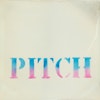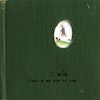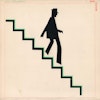What is Pitch? A property of sound that varies with the frequency of vibration, or the act of tossing a ball? Perhaps it’s a condensed version of an idea used to sell a product or oneself. Is it a sharp angle or the violent rocking of a boat on the sea? What about a dark viscous substance?
Marc Canter and Stuart Sharpe were Pitch, and they were able to synthesize all of the above ideas on their lone, mysterious 12-inch release. In the late ’70s, these hardwired mega-geeks dreamt of constructing a “Soundvision Machine”—an interactive performance device that would incorporate MIDI keyboards, touch-screen displays, state-of-the-art microphones, and video equipment. Their excitement over knobs, sliders, and buttons grew over the years, and by 1981, the future was closer than ever. The friends found themselves in NYC at the center of the outskirts of the music world. The no-wave scene was in full swing. While it burned brightly, these two were helping build the Noise NY recording studio. To supplement their digital arsenal, they enlisted Gee Gillespie (drums, hands, and feet) and a band of downtown luminaries, including Naux, who would soon join Richard Hell’s Voidoids. His guitar buzzes like an incredulous gnat around Raquel’s seductive vocals on the A-side. The flip is a brassy blast of delay-filled gratification that was cowritten by Sonic Youth’s first drummer, Richard Edson.
The throbbing bleat of electric sheep feed this cough syrup–induced psychosexual nightmare. There is no escape from New York when the miasma of swirling synthesizers, distressed tape, and evocative hand percussion drag you down into its sticky tar. All you can do is ask, “What am I gonna do for fun?” But the question is rhetorical and bends back on itself leading to a loop of pre-ironic ennui.
The group was gone almost before they were there. Shortly thereafter, Canter cofounded the company that became Macromedia and began working for an upstart called Apple Macintosh. And while he would realize some of his earliest dreams by helping to create the first multimedia player, his rock-and-roll fantasy slipped back into the pitch.


